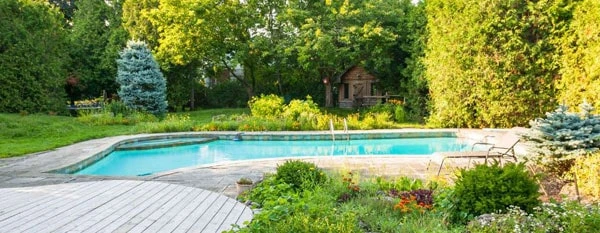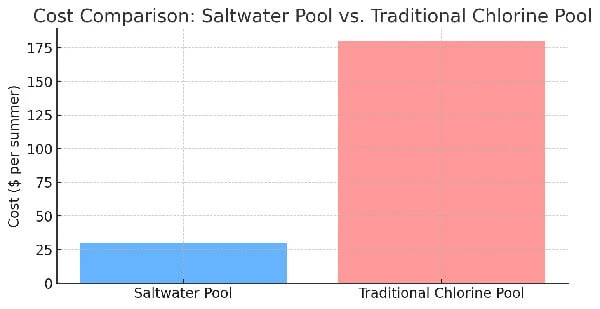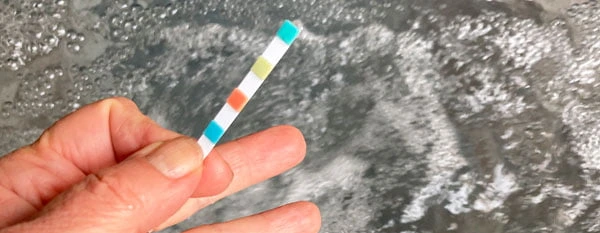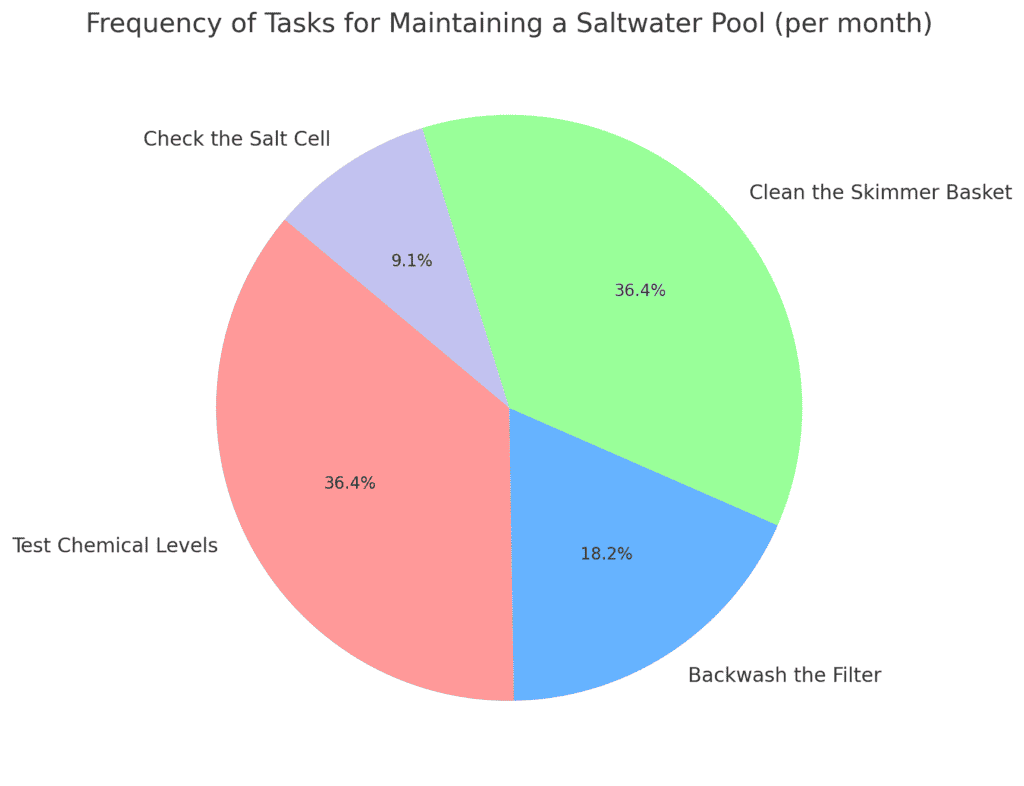A saltwater pool is a popular choice for many homeowners because it uses salt to keep the water clean instead of harsh chemicals like chlorine. However, many pool owners are unsure about how much salt their pool needs to maintain the ideal salt level.
The optimal salt level for a saltwater pool is between 2,700 and 3,400 parts per million (ppm), with 3,200 ppm being the sweet spot.
In this article, I wanted to break down the ideal amount of salt to use in a saltwater swimming pool. I’ve provided a handy pool salt calculator and also have some tips to maintaining your pool.
How Much Salt Does a Saltwater Pool Use?
The ideal salt level for a saltwater pool is between 2,700-3,400 ppm, with 3,200 ppm being the ideal level. Calculating the amount of salt needed for your pool depends on several factors, including the pool’s volume and the ideal salt level.
Note on using this calculator when you are initially adding salt to fresh water in your pool: instead of entering ‘0’ in the ‘Current Salt Concentration’ box, enter a very small number like ‘1’. Entering zero (annoyingly) doesn’t work.
I like to add about 90% of what the pool calculator says to add, then run the pump for a while. I then retest the salt level and adjust accordingly. This way I don’t over-add or over-use salt. The amount of salt that is needed can vary a bit from system to system depending on factors like depth/shallowness of your pool, the type of salt cell that you use, the concentration of Stabilizer, the alkalinity level and the pH. By “dialing in” the salt level in stages, you will get the best results.
Testing Salt Levels
Testing the salt levels in your pool is essential to ensure the proper functioning of the salt chlorine generator. You can use salt test strips or a testing kit to measure the salt levels in your pool.
To test the salt levels, take a water sample from the pool and follow the instructions on the test strip or kit.
Easy to use pool water testing strips quickly show you the levels of pH, Chlorine, Alkalinity and more. Most importantly, these strips will tell you what your Salt level is, which most pool test strips are not designed for.
The test will provide a reading in ppm (parts per million). If the salt level is too low, you will need to add salt to the pool. If the salt level is too high, you can dilute the pool water or wait for the salt level to decrease naturally.
It is important to note that other factors, such as the pool’s alkalinity and pH levels, can also affect the amount of salt needed in your pool. It is recommended to test the salt levels regularly and adjust as needed to maintain the ideal level.

What Salt Should I Use for my Pool?
That subject has a lot of factors to consider – so we’ve written a separate article on just that: Is All Pool Salt The Same? Understanding the Differences.
How Does a Saltwater Pool System Work?
Saltwater pool systems offer a number of benefits over a regular chlorine pool with the added plus that it’s easier to float! Saltwater swimming pools draw on dissolved salt in the water to generate chlorine, which is required to sanitize the pool water. Here’s how it works:
- Salt is added to the pool water to bring your salt levels up to 3,200 PPM. The amount of salt added depends on the total amount of water in your pool, including the pump/plumbing/filtration system.
- The saltwater passes through a salt cell, also known as a chlorine generator. The cell uses electrolysis to convert the salt into chlorine gas. The chlorine gas dissolves in the water and sanitizes the pool.
- The chlorine in the water reverts back to salt through a process called electrolysis. This cycle continues, and the salt level remains constant as long as there is no water loss due to splash-out, backwashing or leaks within your system.
The saltwater pool system is a low-maintenance option compared to traditional chlorine pools. The system requires less monitoring and maintenance since the chlorine level is automatically regulated by the salt cell. Additionally, saltwater pools are gentler on the skin and eyes, making them a more comfortable swimming experience.
Pros and Cons of a Saltwater Pool
Saltwater pools have become increasingly popular in recent years due to their many benefits. However, like any other pool, they also have their drawbacks. In this section, we will discuss the pros and cons of a saltwater pool.
If you are just starting to explore the idea of using saltwater in your pool, or having a saltwater system installed in a new pool, we cover the Pros and Con and other considerations of saltwater in this article: Converting A Swimming Pool Into A Saltwater Pool: Can It Be Done.

Can You Put Too Much Salt in a Saltwater Pool?
While salt is essential for the operation of a saltwater chlorinator system, excessive salt levels can lead to several issues:
- High Salinity: When salt levels exceed the recommended range (typically between 2700 to 3400 ppm), the water becomes excessively salty. This high salinity can cause discomfort for swimmers, making the water feel overly “salty” and potentially irritating to the eyes, skin, and mucous membranes.
- Corrosion: Excessive salt levels can accelerate the corrosion of metal components in and around the pool, including ladders, handrails, and pool equipment. Corrosion can lead to premature equipment failure and potentially costly repairs.
- Damage to Pool Surfaces: High salt concentrations can also damage certain pool surfaces, especially those made of stone or concrete. The salt can draw moisture to the surface, causing efflorescence and weakening the structure over time.
- Poor Chlorine Production: Paradoxically, extremely high salt levels can negatively impact the performance of saltwater chlorinators. If the salt concentration is far beyond the recommended range, the chlorine production might decrease, leading to inadequate sanitization of the pool water. More is not better!
- Increased Maintenance Costs: Adding excessive salt can lead to unnecessary expenses, as you’ll need to dilute the pool water or partially drain and refill the pool to lower the salt concentration.
- Soil Salinization: If pool water containing excessive salt is allowed to seep into the surrounding soil, it can lead to soil salinization. High salt levels in the soil can disrupt the osmotic balance of plant roots, making it difficult for them to absorb water and essential nutrients. This can result in stunted growth, wilting, and eventually, the death of plants.
- Disruption of Microbial Activity: High salt levels in the soil can also negatively affect soil microbial activity, reducing the beneficial interactions between plants and soil microbes. This disruption can further impact the overall health and nutrient cycling in the surrounding ecosystem.
To avoid these issues, monitor the salt concentration in your saltwater pool regularly. Use a saltwater test kit to measure the salt level and make adjustments as necessary to keep it within the recommended range. When adding salt, I like to add about 90% of what the calculator indicates, then test again. With the updated salt level in PPM, use the calculator again to find out if you need to add a small amount more. If you follow this procedure over-adding salt likely will not occur.
Even if you have not recently added salt, but you’ve had dry and windy weather that evaporates the water from your pool, your salinity level can go up. People with pools in dry desert areas need to be particularly aware of this issue. Be sure to top off the pool system with fresh water when you have these conditions.
Once you’ve reached the right concentration of salt, saltwater chlorination systems do not really “use up” the salt. Instead, there is a cycle of chlorine generation and re-combination with the sodium. To learn more about that, and to understand what is happening if your salt concentration does seem to be decreasing, see Where Does Pool Salt Go? Understanding the Dissolving Process.
If you suspect that you’ve added too much salt, you might want consult with a pool professional to determine the best course of action for restoring the proper salt balance in your pool. DIY options include:
- Pump or drain out some of the saltwater and replace it with fresh water
- If you use a pool cover, you might want to leave it open until the salt levels come down. Since exposure to sunlight tends to dissipate chlorine, and producing more chlorine consumes salt, not covering your pool can help move concentrations in the right direction. This may increase debris in your pool and you’ll need to monitor children/pets while the cover is open.
Additionally, follow the manufacturer’s guidelines and recommendations for your specific saltwater system to ensure the pool operates effectively and safely.

Maintaining a Saltwater Pool
Saltwater Pool Maintenance
Maintaining a saltwater pool requires regular maintenance to keep the water clean and healthy. One of the advantages of a saltwater pool is that it uses a saltwater chlorinator to produce chlorine, which means you don’t need to add traditional chlorine to the pool. However, you’ll still need to shock the pool if it becomes dirty or algae-infested.
To keep your saltwater pool in optimal condition, you should test the chemical levels in the water at least once a month. This includes testing the pH level, free chlorine, alkalinity, calcium, stabilizer, and salt levels. While you can purchase a test kit from a pool store or hire a local professional to test the water for you the latest test strips that are available make testing up to eight water quality levels as simple as swishing a little wand in the water. I’ve linked my favorite test strips at near the top of this article for your convenience.
Saltwater Pool Equipment
There are several pieces of equipment you’ll need to maintain a saltwater pool. These include:
- Salt Cell: The salt cell is responsible for producing chlorine from the salt in the water.
- Skimmer: The skimmer removes debris from the surface of the water.
- Chlorinator: the chlorinator distributes the chlorine throughout the pool.
- Filter: The filter removes impurities from the water.
- Pump: the pump circulates the water through the system.
It’s important to keep all of the equipment in good working condition to ensure that your pool stays clean and healthy. You should backwash the filter regularly and clean the skimmer basket to prevent clogging. You should also check the salt cell periodically to make sure it’s clean and functioning properly.
Tips for Keeping a Saltwater Pool Healthy
To keep your saltwater pool healthy, you should maintain the proper salinity levels and total dissolved solids. The ideal salinity level for a saltwater pool is between 2,700 and 3,400 parts per million (ppm), with 3,200 ppm being ideal. You can use our pool salt calculator at the top of this article to determine how much salt to add to the water.
High levels of total dissolved solids can cause scaling and corrosion in the pool, so it’s important to monitor these levels and drain and refill the pool as necessary. You should also run the pump for at least 8 hours a day to keep the water circulating.
Finally, you should be vigilant about algae and other microorganisms in the water. Regular testing and maintenance should help prevent these issues, but if you do notice algae or other problems, you should address them promptly to keep your pool in the circular sweet spot of a healthy saltwater pool.

What Additives Should Go Into a Saltwater Pool?
Several additives are important for maintaining a healthy and balanced saltwater pool. These additives help to ensure water clarity, prevent algae growth, and optimize the performance of the saltwater chlorination system. Here are some common additives that are almost always needed for a saltwater pool:
- Stabilizer (Cyanuric Acid): Cyanuric acid is used to stabilize chlorine in the pool water, protecting it from degradation by the sun’s UV rays. This helps maintain a more consistent chlorine level and reduces the amount of chlorine lost to sunlight. The recommended cyanuric acid level is typically between 30 to 50 ppm.
- pH Increaser (Sodium Carbonate) or pH Reducer (Muriatic Acid): Maintaining the correct pH level is crucial for water balance. pH increasers (like sodium carbonate) raise the pH when it is too low, while pH reducers (like muriatic acid) lower the pH when it is too high. The recommended pH level for a saltwater pool is typically between 7.4 to 7.6. Usually you only need to balance pH when you initially fill a pool or when you need to add water to account for evaporation. Otherwise, pH will tend to stay in range once you get it there.
- Alkalinity Increaser: Helps stabilize the pH in a pool – so sometimes is is called a ‘Buffer’. If your alkalinity is within range, while it doesn’t increase the pH itself, it helps you keep the pH levels from bouncing around. Some products are labeled with a name like ‘Pool Up’ or ‘Spa Up’ because they combine an Alkalinity Increaser with comparable amount of pH increaser, since the two values are related. The alkalinity level should be between 80 and 120 parts per million (ppm).
- Saltwater Shock: Shocking the pool involves periodically adding a higher-than-normal dose of chlorine to rapidly oxidize and eliminate contaminants like bacteria, chloramines, and other organic matter. You can use a saltwater-compatible shock product specifically designed for saltwater pools. Water that gets a heavy bather load (like in a spa) can need to be shocked once a week. Pools need shocking less often, especially if the pool is not getting a lot of use.
This additive might get used in your pool, depending on your source of water:
- Calcium Hardness Increaser: Calcium hardness refers to the amount of dissolved calcium in the water. If the calcium hardness level is too low, the water can become corrosive, potentially damaging pool surfaces and equipment. Calcium hardness increasers help raise the calcium hardness level to the recommended range (usually 200 to 400 ppm). Be VERY CAREFUL with this stuff – I once added too much and it completely fouled my micro-filter. A crust of hard grey/white material made the filter impossible to clean so I just had to replace it, even though it was only a couple weeks old. I think the test strip I was using was old & was not giving me an accurate Calcium Hardness reading.
The additives below should only be needed if your water does not come from a municipal water source – such if you get your household water from a well (or other natural source):
- Scale Inhibitor: Scale inhibitors help prevent the formation of mineral scale on pool surfaces and equipment. This is particularly important if you have hard water in your area, as high calcium levels can lead to scale buildup.
- Metal Sequestering Agent: If your pool water has high metal content (e.g., iron, copper), a metal sequestering agent can help prevent metal stains and discoloration on pool surfaces. This condition usually only exists if you are using well water in your pool – municipally supplied water has already been treated for high metal levels.
This additive will probably only be needed if your pool gets out of balance or if it has irregular maintenance:
- Algaecide: While saltwater pools are generally more resistant to algae growth than traditional chlorine pools, occasional algae outbreaks can still occur. Algaecides help prevent and control algae growth, keeping the water clear and clean. Staying on top of salt & chlorine levels can avoid having to add algaecide in most cases.
Remember that you can consult with a saltwater pool professional to learn how to do pool water quality balancing. The amount needed of each product and how often they should be added will be determined by other aspects such as pool size, usage, and the chemical balance of your cities water used to fill the pool.

Draining a Saltwater Pool
There are times when a pool needs to be drained. Sometimes it’s when major maintenance to be done. In some areas of the country, pools need to be drained or partially drained for the winter. Whatever the reason, care needs to be taken with saltwater to drain the pool in such a way that it will not affect nearby vegetation.
If plants are repeatedly exposed to high levels of salt, the salt can build up in the soil, leading to long-term damage. When draining a saltwater pool, it is important to direct the exiting water to a location where it can drain away without draining through the soil in your yard (or someone else’s yard). In town, your best bet is a paved gutter that leads to a storm sewer. When you live in a rural area, care needs to be taken to drain saltwater at a safe distance away from waterways like creeks and streams.
If saltwater draining does unintentionally soak any nearby vegetation, it is good to flush the area with fresh water from a hose or your irrigation system.
What to Do After Adding Salt to your Pool
After figuring out how much salt to add to your pool, there are several important steps to take to ensure the salt is properly distributed and the pool functions optimally as a saltwater pool:
- Circulate the Water: Turn on the pool circulation system, typically the pump and filter, to help distribute the salt evenly throughout the water. Allow the pump to run for several hours to ensure proper mixing.
- Test the Salt Level: Use a saltwater test kit to measure the salt concentration in the pool water. This will verify if the salt has been added in the correct amount to achieve the desired salt concentration, typically targeting 3200 ppm. Check the manual of the salt cell you are using to confirm that it is designed for this salt concentration.
- Adjust Salt Levels (if needed): If the salt concentration is not within the desired range, you may need to add more salt or dilute the water with fresh water to achieve the target ppm level.
- Check Other Water Parameters: While testing the salt level, also check the pool’s pH, total alkalinity, and calcium hardness. Ensure that these parameters are within the recommended ranges to maintain water balance and prevent issues like corrosion or scaling.
- Wait for Dissolution: Salt dissolves slowly in water, so allow sufficient time for the added salt to dissolve fully before testing the salt concentration again.
- Retest and Monitor: After allowing enough time for dissolution, retest the salt level. Monitor the salt concentration regularly, especially during the swimming season, to ensure it remains within the desired range.
- Maintain Pool Chemistry: Continue to monitor and adjust the pool’s pH, alkalinity, and other chemical levels as needed to maintain a healthy and comfortable swimming environment.
- Enjoy Your Pool: Once the salt is adequately dissolved, the water is balanced, and the salt concentration is within the target range, you can enjoy the benefits of swimming in a saltwater pool, which include softer-feeling water and potentially lower maintenance costs compared to traditional chlorine pools.
Remember that all of the things you add to the pool: water, salt, and additives all interact with each other. Don’t get in too much hurry when you are first getting set up, circulate the water for a while and go through the test/adjust process a few times. You’ll get better results and won’t overload your pool with too much of one or more products. After you’ve done it a couple times the process will go faster. Making a log of what you do will also help the next time you refresh water or do maintenance.
Final Thoughts
Saltwater pools are often preferred over traditional chlorine pools because they are easier to maintain, less harsh on skin and eyes, and produce a more natural swimming experience. Additionally, saltwater pools do not require the frequent addition of chlorine, which can save time and money in the long run.









